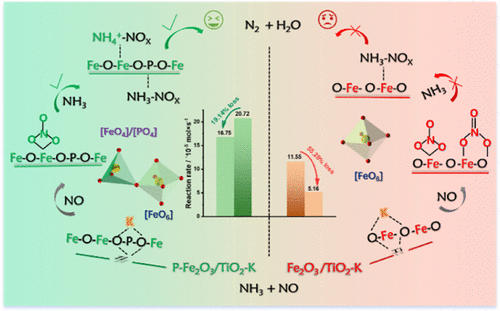当前位置:
X-MOL 学术
›
Environ. Sci. Technol.
›
论文详情
Our official English website, www.x-mol.net, welcomes your
feedback! (Note: you will need to create a separate account there.)
Improved NOx Reduction over Phosphate-Modified Fe2O3/TiO2 Catalysts Via Tailoring Reaction Paths by In Situ Creating Alkali-Poisoning Sites
Environmental Science & Technology ( IF 10.8 ) Pub Date : 2021-06-18 , DOI: 10.1021/acs.est.1c01722 Yue Li 1, 2 , Sixiang Cai 2 , Penglu Wang 1 , Tingting Yan 1 , Jianping Zhang 1 , Dengsong Zhang 1
Environmental Science & Technology ( IF 10.8 ) Pub Date : 2021-06-18 , DOI: 10.1021/acs.est.1c01722 Yue Li 1, 2 , Sixiang Cai 2 , Penglu Wang 1 , Tingting Yan 1 , Jianping Zhang 1 , Dengsong Zhang 1
Affiliation

|
The deactivation issue arising from alkali poisoning over catalysts is still a challenge for the selective catalytic reduction of NOx by NH3. Herein, improved NOx reduction in the presence of alkaline metals over phosphate-modified Fe2O3/TiO2 catalysts has been originally demonstrated via tailoring the reaction paths by in situ creating alkali-poisoning sites. The introduction of phosphate results in the partial formation of iron phosphate species and makes the catalyst to mainly exhibit the characteristics of FePO4, which is responsible for the widened temperature window and enhanced alkali resistance. The tetrahedral [FeO4]/[PO4] structures in iron phosphate act as the Brønsted acid sites to increase the catalyst surface acidity. In addition, the formation of an Fe–O–P structure enhances the redox ability and increases surface adsorbed oxygen. Furthermore, the created phosphate groups (PO43–) serving as alkali-poisoning sites preferentially combine with potassium so that iron species on the active sites are protected. Therefore, the enhanced NH3 species adsorption capacity, improved redox ability, and active nitrate species remaining in the phosphate-modified Fe2O3/TiO2 catalyst ensure the de-NOx activity after being poisoned by alkali metals through the Langmuir–Hinshelwood reaction pathway. Hopefully, this novel strategy could provide an inspiration to design novel catalysts to control NOx emission with extraordinary resistance to alkaline metals.
中文翻译:

提高NO X还原过磷酸盐改性的Fe 2 ö 3 /二氧化钛2条催化剂通过裁缝反应路径通过原位创建碱中毒站点
催化剂碱中毒引起的失活问题仍然是NH 3选择性催化还原NO x的挑战。在本文中,与磷酸盐改性的 Fe 2 O 3 /TiO 2催化剂相比,在碱金属存在下改进的 NO x还原最初是通过原位创建碱中毒位点来定制反应路径来证明的。磷酸盐的引入导致部分形成磷酸铁物种,使催化剂主要表现出FePO 4的特性,这是导致温度窗口变宽和耐碱性增强的原因。磷酸铁中的四面体 [FeO 4 ]/[PO 4 ] 结构充当布朗斯台德酸位以增加催化剂表面酸度。此外,Fe-O-P结构的形成增强了氧化还原能力并增加了表面吸附的氧。此外,作为碱中毒位点的磷酸基团 (PO 4 3- ) 优先与钾结合,从而保护活性位点上的铁物质。因此,增强的 NH 3物种吸附能力、提高的氧化还原能力和活性硝酸盐物种保留在磷酸盐改性的 Fe 2 O 3 /TiO2催化剂通过Langmuir-Hinshelwood反应途径确保被碱金属中毒后的脱NO x活性。希望这种新颖的策略可以为设计新颖的催化剂提供灵感,以控制对碱金属具有非凡抵抗力的NO x排放。
更新日期:2021-07-06
中文翻译:

提高NO X还原过磷酸盐改性的Fe 2 ö 3 /二氧化钛2条催化剂通过裁缝反应路径通过原位创建碱中毒站点
催化剂碱中毒引起的失活问题仍然是NH 3选择性催化还原NO x的挑战。在本文中,与磷酸盐改性的 Fe 2 O 3 /TiO 2催化剂相比,在碱金属存在下改进的 NO x还原最初是通过原位创建碱中毒位点来定制反应路径来证明的。磷酸盐的引入导致部分形成磷酸铁物种,使催化剂主要表现出FePO 4的特性,这是导致温度窗口变宽和耐碱性增强的原因。磷酸铁中的四面体 [FeO 4 ]/[PO 4 ] 结构充当布朗斯台德酸位以增加催化剂表面酸度。此外,Fe-O-P结构的形成增强了氧化还原能力并增加了表面吸附的氧。此外,作为碱中毒位点的磷酸基团 (PO 4 3- ) 优先与钾结合,从而保护活性位点上的铁物质。因此,增强的 NH 3物种吸附能力、提高的氧化还原能力和活性硝酸盐物种保留在磷酸盐改性的 Fe 2 O 3 /TiO2催化剂通过Langmuir-Hinshelwood反应途径确保被碱金属中毒后的脱NO x活性。希望这种新颖的策略可以为设计新颖的催化剂提供灵感,以控制对碱金属具有非凡抵抗力的NO x排放。


















































 京公网安备 11010802027423号
京公网安备 11010802027423号